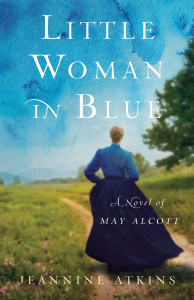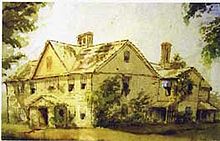Little Woman in Blue conjures the world of Little Women’s Alcott sisters so vividly that readers will find themselves astonished to look up from the page and not be living in nineteenth-century Concord, Massachusetts. Jeannine Atkins’ first adult novel, after several children’s books including Becoming Little Women: Louisa May at Fruitlands, delivers a refreshing look at May Alcott, perhaps the least known of the Alcott sisters. Showing that May, portrayed as pampered Amy, the youngest of the Alcott sisters in Little Women, was in reality an accomplished artist and a contemporary of Mary Cassatt and Berthe Morisot, will surprise most readers. It’s difficult to decide whether Atkins’ rich portrayal of May Alcott as an indomitable artist or her adroit portrait of the natural world of nineteenth-century Concord is more compelling. Thankfully, Atkins skillfully weaves them both into a delightful novel that will appeal to fans of the wonder Lydia Cassatt Reading the Morning Papers.
The sibling rivalry between May and Louisa is palpable and Atkins illustrates the manner in which the strong-willed women love each other but often can’t grasp the other’s needs. After May returns from a stint teaching at a mental institution, Louisa has trouble grasping May’s yearning to return to her art. Louisa tells her:
“I can’t see the use of art, when beauty is right here.” Louisa took a notebook from her basket and propped it on her knees.
“But not everyone sees it. Artists try to point out the ordinary splendors.” May borrowed paper and a pencil to sketch the pond and hill where Mr. Thoreau had lived for two years, two months, and two days. She even drew the cabin. The world seemed to turn quiet while she moved her hand.
Louisa glanced at her paper. “His little house is gone.”
“Can’t you see it?” May squinted at the pines and hemlocks.
“Across town, where it was hauled to store grain.”
“Look harder.”
“I liked him.”
“I know,” May touched her hand, then added a rowboat to the picture, showing the back of a man holding oars. The more she moved her pencil, the more shapes and hues she saw in the shadows. “A view like this seems like a message from the world. Drawing is my way to keep up my end of the conversation. I’ve missed it.”
The remarkable confluence of talent residing in their small neighborhood, where Ralph Waldo Emerson, Henry David Thoreau, and Nathanial Hawthorne all lived alongside Bronson Alcott and his family, is revealed via clever conversations and facts culled from diaries and journals. May’s romance with Julian Hawthorne, son of neighbor Nathanial, reflects the culture in which they lived. It’s expressed in his lack of support for her ambition when, upon his return from Paris and a visit to the Louvre, May asks him:
“How can I paint when I’ve seen prints borrowed from the Emersons but not a real brushstroke from Michelangelo’s hand? No one expects Louisa to write without having read great books.”
“Surely you’re not serious about art.”
“I hope you don’t say that because I’m a woman.”
“I don’t believe a single painting in the Louvre was made by one.”
 When May reads her sister’s portrayal of her as “Amy,” the sister who forfeits her need to become an artist to marry and have a family, May is even more determined to become a successful artist and to have a family. May gives art lessons to earn money to supplement the meager Alcott family earnings and to take art lessons in Boston herself. She even gives Daniel Chester French lessons that allow him to begin his training as a sculptor.
When May reads her sister’s portrayal of her as “Amy,” the sister who forfeits her need to become an artist to marry and have a family, May is even more determined to become a successful artist and to have a family. May gives art lessons to earn money to supplement the meager Alcott family earnings and to take art lessons in Boston herself. She even gives Daniel Chester French lessons that allow him to begin his training as a sculptor.
Atkins documents May’s journey to self-discovery with a subtle grace that allows the reader to watch May grow as she leaves comfortable Concord for Europe when the success of Little Women earns Louisa the funds to pay for May to study there. This results in her becoming an accomplished artist garnering praise from the venerable John Ruskin, May becomes friends with Mary Cassatt and May’s still life gains admittance to the Salon, the coveted official art exhibition of the Académie des Beaux-Arts in Paris, before paintings by Cassatt and other women. May’s personal life flourishes, she falls in love, and she continues painting.
“That summer, May often painted in the garden, concentrating on passing light more than solid shapes, letting poppies spill off the page rather than stand in the center. She used the wrong end of a brush to scratch or scrape away paint to expose the white paper and suggest texture. The spaces made what she left more vivid.”
Jeannine Atkins’ novel, Little Woman in Blue, scrapes away what we thought we knew of Louisa May Alcott’s youngest sister and exposes the vivid life she lived as an accomplished artist and woman of the nineteenth century. It’s a vibrant rendering of a life lived with purpose during a time when women weren’t supported in following their dreams.
 Summing it Up: Read this enchanting historical novel to embed yourself in the life of May Alcott, an artist we all should know. Fans of Girl with a Pearl Earring, Little Women, and The Luncheon of the Boating Party will want to select this for their book clubs. Little Woman in Blue is available as an original paperback and in a digital edition for e-readers making it a title book clubs might wish to choose immediately.
Summing it Up: Read this enchanting historical novel to embed yourself in the life of May Alcott, an artist we all should know. Fans of Girl with a Pearl Earring, Little Women, and The Luncheon of the Boating Party will want to select this for their book clubs. Little Woman in Blue is available as an original paperback and in a digital edition for e-readers making it a title book clubs might wish to choose immediately.
May Alcott's art: Top left: Orchard House, a watercolor of the Alcott family home before 1879; Middle Right: Westminster Abbey, watercolor, La Négresse, 1879, exhibited at the 1879 Paris Salon
Rating: 4 stars
Category: Fiction, Grandma’s Pot Roast, Pigeon Pie, Super Nutrition, Book Club
Publication date: September 15, 2015
Author Website: http://www.jeannineatkins.com/books/little_woman_blue.htm
Interview with the Author: http://www.jeannineatkins.com/books/little_woman_conversation.htm
Reading Group Guide: http://www.jeannineatkins.com/books/Reading-Group-Guide.pdf
What Others are Saying:
“Little Woman in Blue is an inspiring and engaging fictional portrait of the artist May Alcott, written with knowledge, sensitivity, and beauty. It is wonderful to see May Alcott gain the center of her own story, and inhabit it with such generosity and grace.”
—Harriet Scott Chessman, author of Lydia Cassatt Reading the Morning Paper
—Harriet Scott Chessman, author of Lydia Cassatt Reading the Morning Paper
Historical Novels Review: https://historicalnovelsociety.org/reviews/little-woman-in-blue/
Library Journal: “Devotees of Louisa May Alcott’s Little Women will be intrigued by this fictionalized biography of the women behind the characters.”


Thank you! I'm so happy you enjoyed getting to know May!
ReplyDeleteI hadn't heard of this one but I definitely now want to read it! Great review.
ReplyDelete